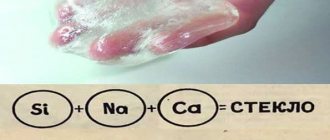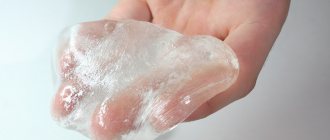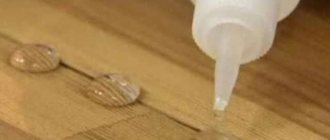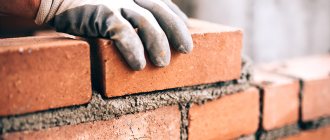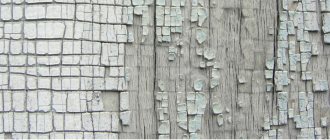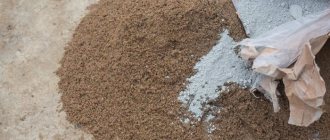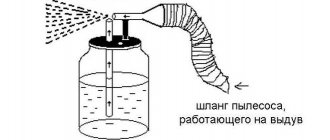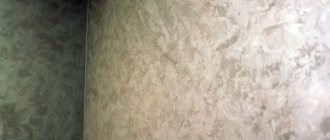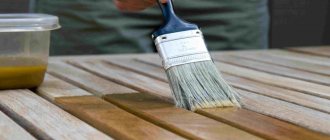Glass has always been indispensable in construction, as it has many useful properties and can be used in various fields. By its chemical nature, liquid glass comes in two types - based on an aqueous-alkaline solution of potassium or sodium silicates. Most often you can find the sodium version on sale. Liquid glass is most often used in construction with a density of 1300-1500 kg/m3 and a silicate module of 2.6-3. Potassium glass is more expensive. It can be found in the manufacture of silicate paints and adhesives. The potassium version differs favorably from the sodium version in that it does not cause efflorescence on the plaster and paint.
Using ZhS
The use of liquid glass in construction is due to its qualitative properties. It increases water resistance, which is especially important when constructing foundations for hydrological structures (fountain, pool, etc.). It also increases the heat-resistant qualities of bases for stoves, fireplaces and other heating devices.
Coating insulation of the pool bowl with glue Source dm-art-design.ru
The more liquid glass you add to concrete, the faster it will set, for example:
- if the material is 2%, then you can walk on the solution after a day;
- at 10% – after 6 hours.
Excellent waterproofing and heat-resistant mixtures are prepared from this glue. The primer is made from cement, water and liquid glass. Excellent insulation is obtained from glue and sand. The use of liquid glass has shown excellent results on the walls of wells, wet tunnels and basements.
The refractory mixture is made from sand and cement with the addition of office glue. The walls of the fireplace and stove are treated with it using a wide brush. In addition, you can use liquid glass for wood in the form of an antiseptic. To do this, the glue should be diluted with water.
Wood treated with glue Source www.cedar-stuff.com
Liquid glass is applied to a vertical surface in an even layer using a regular paint brush; on a horizontal surface it is easier to pour it and spread it with a squeegee or spatula. If the coating with liquid glass is supposed to be double-coated, then the first layer must dry completely.
Advantages and disadvantages
The service life of liquid glass, according to the warranty card, is 5 years. During use, it was noticed that after this period the coating begins to gradually deteriorate, losing 1 mm of thickness every year. To extend the service life, it is recommended to apply a layer of paint on top of the waterproofing.
The material qualitatively fills cracks and pores in concrete, plaster, brick, wood and other materials.
To increase the strength and abrasion resistance of the cement mortar, 1 to 10% liquid glass is added to it, not forgetting that the setting time of the mortar is significantly reduced. If you increase the dosage, the coating will become fragile and unstable to mechanical damage.
For a person who does not have experience working with this material, it may be difficult to apply it.
Liquid glass hardens within 30 minutes. If you dilute more material than you have time to apply it to the floor, the glass will harden and will be unsuitable for reuse.
Liquid glass - what is it?
This term refers to a water-soluble mixture of potassium or sodium silicates. Lithium silicates are used for electrode coating. The material has a viscous structure and consists of tiny crystals. When they hit the surface, they increase in size and fill microscopic cracks and pores. This creates a water-repellent and heat-resistant layer.
Penetrating waterproofing: applying a solution with LC Source obustroeno.com
The formulas of liquid glass or silicate glue are as follows: K2O(SiO2)n or Na2O(SiO2)n.
This glue was first obtained by the German mineralogist and chemist Jan Nepomuk von Fuchs in 1818 by the action of alkali on silicic acid. In addition to waterproof concrete and cement, potassium or sodium liquid glass is used for:
- preparing fireproof paint;
- gluing linoleum and PVC boards;
- self-leveling floors;
- antipyrrhenes for wood;
- impregnation of fabrics;
- securing weak soil;
- cellulose gluing.
If you add liquid glass to a cement solution, then after hardening you will get a very durable monolith.
What is the material
Silicate glue or, as it is otherwise called, liquid glass is an aqueous solution of silicate salts. Depending on the main component there are:
- sodium liquid glass, characterized by a high degree of adhesiveness, fire resistance, antiseptic and waterproofing properties;
- potassium, which is immune to atmospheric influences and acid attack.
Soda glass is used to accelerate the hardening process of cement mixtures due to the chemical reaction that occurs.
Liquid glass has become widespread as a construction and finishing material due to its properties:
- Hydrophobic (water-repellent). Thanks to this property, liquid glass is used to treat surfaces exposed to prolonged contact with liquid, including wood products. As a result of impregnation, they will not be subject to swelling and deformation.
- Antiseptic. This property allows the use of silicate glue for protective impregnation of walls against such negative manifestations as mold and mildew.
- Fireproof. Impregnating floors and walls with liquid glass increases the fire safety of the room.
- Antistatic. The material eliminates electrification and does not provoke the occurrence of static electricity.
- Acid-resistant. Impregnation with a silicate solution helps protect the surface from exposure to chemicals.
- Eco-friendly. This material does not emit substances harmful to the human body.
Proportions and mixing
Depending on the purpose of use, the proportions of the various components of the solution are chosen. Ready-made mixtures intended for a particular task are more expensive, so solutions prepared directly at a construction site are often used.
Stationery glue on the floor Source fundamentplus.com
Composition for coloring
The effect of silicates on coloring pigments significantly limits the number of shades. Potassium silicate is used to prepare coloring compositions - it gives a more uniform color, unlike sodium. Such dyes are produced in ready-made versions; you only need to combine 2 components.
See also: Projects of houses with second light
Primer
To get a good primer, glue and cement should be taken in equal quantities. This coating will significantly strengthen the concrete foundation. Lighter solutions are made for tiles.
Impregnation
To increase the service life of elements and structures, an aqueous adhesive solution is used in a ratio of 1/5. Impregnate with a spray gun or brush. Small items can be completely immersed in the mixture.
Waterproofing
To protect concrete from water, prepare a solution of sand, cement and glue in equal parts. Water is added until the mass becomes homogeneous and plastic.
Fire protection
Masonry mortar with heat-resistant properties consists of cement and sand in a ratio of 1/3. Water is added until a plastic consistency is obtained, silicate glue is added last and makes up approximately 20% of the mass.
Kinds
There are several types of liquid glass. They are divided depending on the main substance used in the mixture.
Sodium
The formation based on sodium salts is characterized by a viscous structure, high strength and penetrating ability. It perfectly resists open fire and high temperatures, and the composition is also able to retain its shape even when the base on which it was applied is deformed.
Potassium
This material contains potassium salts. The structure of the mixture is loose, the composition has increased hygroscopicity, and forms a matte surface. Potassium compounds resist excessive heat and deformation well.
Lithium
It is used to provide the treated surface with protection from thermal effects. Produced in small batches. For some work, combined mixtures are used.
Video description
In the video, testing wood treated with liquid glass for combustibility:
Antiseptic
To prevent rotting and damage to surfaces by fungus and mold, structures are treated with liquid glass diluted with water in a ratio of 1/1. Use glue for processing concrete and wood.
Repair composition
Liquid glass, cement and sand are taken in a ratio of 1/1/3. Water is added until a sufficiently thick consistency is obtained so that the solution does not flow out of the cracks when they are eliminated. The mixture is also used when sealing joints and pouring screeds.
Mixing the solution
To properly mix a solution using liquid glass, you must follow the recommendations for certain mixtures for treating and repairing surfaces. Dry ingredients and glue with water are mixed separately.
Screed with ZhS Source i9.photo.2gis.com
See also: Specialize in the design and construction of small forms
Dry components are added in parts to the solution, and not vice versa. For greater plasticity, the volume of water is increased. The mixture is applied to the surface, taking into account finishing technologies.
Preparation of silicate solution - tools and consumables
When working with liquid glass, it is best to use ready-made mixtures designed to perform a specific task.
The disadvantage of such mixtures is the high cost and the need to completely use up the entire purchased container. The latter is due to the increased rate of hardening of the mixture after air enters it.
It is much cheaper to use individual components, so manual preparation of solutions is more common, especially since there are a large number of ways to use it.
For a small scope of work in home construction, you will need a set of tools and materials:
- Bucket used only for construction work. The toxicity of silicates is low, but storing food products together with them will not be the best solution.
- A drill with an auger attachment designed for mixing thick solutions.
- Brush or spray (if necessary).
- Cement (ordinary Portland cement is sufficient).
- Fine (sifted) sand.
- Running water or well.
- Putty knife.
- Workwear.
It is necessary to mix liquid glass with water and other components in the proportions recommended for a specific type of work. If surface characteristics lead to reduced adhesion of the mortar, the water content can be reduced or the cement content can be increased.
When diluting liquid glass, cold water is used. To control its quantity and not accidentally add more than required, you should stock up on measuring containers of sufficient volume.
Application of liquid glass
When working with potassium or sodium liquid glass, you should use protective equipment - a special suit and mask. If the mixture gets into your eyes or skin, rinse with plenty of water. Since the solution sets quickly enough - within 30 minutes, you need to calculate the one-time volume of the batch. After half an hour, you can apply the next layer.
Basement waterproofing
The basement is an important structure, so protecting it from moisture is the main condition for a favorable atmosphere in the house and the safety of food. Most often in the basement there is poor insulation of joints and the presence of cracks.
Basement insulation diagram Source moydomik.net
To get rid of them:
- first clean the seams and cracks from various inclusions and dust;
- then prepare a solution of silicate glue and cement in a ratio of 1/20, add water until a plastic consistency is obtained;
- then apply the mixture to the seams or cracks and level them with the same solution;
- After this, coat with water using a brush.
After a day, it is better to apply a layer of glue to the repair site.
Treatment of a concrete well, swimming pool
First, the concrete is cleaned with a brush to remove dirt and dust. After this, apply one layer of impregnation with a roller or brush. After half an hour, apply the second layer. Liquid glass should lie evenly, without gaps. Then prepare a solution from a cement mixture and silicate glue in a ratio of 9/1 and apply it with a spatula in 20 minutes, taking into account the low viability of the solution.
Safety precautions during operation
It is recommended to wear rubber gloves and boots when applying glass waterproofing coating.
When diluting liquid glass, a strong alkaline reaction occurs, so you need to prepare a large container with clean water and vinegar.
A weak vinegar solution will neutralize the alkali if it comes into contact with the skin.
When pouring a glass coating, you need to protect the room from drafts. To do this, do not turn on the air conditioner and heating devices until the base is completely dry.
General recommendations for treating concrete bases with liquid glass
The work of processing the concrete base is done quickly - the ready-made liquid silicate adhesive can simply be mixed using a construction mixer. Work should be carried out at temperatures above plus 5 degrees. After collecting the glue, the container is tightly closed. And :
- there is no need to treat external surfaces if frost is expected;
- if there is ice or frost on the base, no work is carried out;
- When processing horizontal areas, puddles are unacceptable.
Any surface must be properly prepared - silicate glue is applied only to dry and clean surfaces. The top loose layer (ironization and cement laitance) is removed using various tools and units. For large areas - this is a grinding machine, sandblasting and shot blasting machine. For hard-to-reach places and in junction areas - hand tools. The resulting sludge and debris are cleaned out with stiff brushes and a construction vacuum cleaner.
Cleaning up garbage with a construction vacuum cleaner Source kwitka.com.ua
Floor waterproofing
Waterproofing with this material allows you to obtain a surface that is impermeable to water and air.
Sequence of surface preparation work:
- We prepare the surface, remove all loose building materials, paint, rust, oil stains and other contaminants from it.
- We sand the surface with a stiff wire brush or sandpaper.
- Remove dust using a powerful vacuum cleaner.
We take into account that it is problematic to apply plaster or putty on a glass floor, since they will not adhere to the surface.
Apply the diluted liquid glass in several layers.
Advantages and disadvantages
Liquid glass has its advantages and disadvantages. The first include:
- low cost;
- low consumption of glue in solutions;
- resistance to precipitation;
- ease of use;
- good adhesion (penetrates 2-3 mm into concrete);
- durability of concrete and protective film.
Along with this, silicate adhesive prevents the accumulation of static electricity and is resistant to acids.
Protective film on wood countertops Source woodspil.ru
Along with the advantages, the material also has disadvantages:
- The protective film is not strong enough and is destroyed by mechanical stress.
- Not applicable on brick.
- When waterproofing the foundations of buildings and structures, rapid crystallization of the composition with the addition of LC occurs.
If the proportions of components in solutions are not observed, it is impossible to obtain the expected result.
Characteristics
ZhS is a material of a viscous, viscous consistency, which dries quickly in air and forms a monolithic, durable, water-impervious base.
Liquid glass, sodium and potassium, have the following characteristics:
- Prevents water from penetrating through the surface treated with the solution.
- Protects wooden and concrete surfaces from the penetration of fungus and pathogens.
- Prevents the accumulation of static voltage.
- Protects the treated surface from fire.
- Protects the base impregnated with the solution from the effects of acidic compounds.
- Helps accelerate the drying process and strength gain of cement mortars.
Ensuring safety precautions
The glue is non-toxic, non-flammable and non-explosive. The prepared mixtures are stored in a dry, cool place at a positive temperature of 5 to 40 degrees.
Safety precautions and precautions Source beton-house.com
Silicate glass is frost-resistant and can withstand temperatures down to minus 34 degrees. The material can withstand 5 freeze/thaw cycles without losing its consumer properties. Should not be placed near heating devices or operating equipment. Residues must be disposed of correctly - do not pour into water bodies, soil or sewers.
Rules for working with material
To ensure a durable coating, you must follow the following rules:
- the temperature range should be from -5 to +30 degrees;
- You need to prepare the mixture in small portions, as it hardens quickly;
- When applied to a metal surface, it must be degreased.
Do not add material undiluted with water to ready-made plaster or cement mortar. We add it in the form of an aqueous solution in compliance with the proportions.
The reasons why the screed will be weak are different:
- Failure to maintain the proportions of water and cement.
- Old cement (with lumps).
- Increased clay content in sand.
- Improper preparation and care after installation when rapid dehydration conditions occur.
But if this happens, then something needs to be done about it - because with further finishing, difficulties are possible.
It is also impossible to leave it unchanged. Dust constantly forms on such a floor. The weak layer is easily destroyed by feet.
First way. Strengthening with primer.
The first thing most people come to is to strengthen it with a primer. The option is real, affordable and on everyone’s lips. But it rarely gives results:
A short comment on the video.
Judging by the nail test, the screed is quite suitable for tiling indoors. There are examples of a more deplorable state of the foundation, which they tried to strengthen with a primer:
For what reason did the tile bounce off the screed?
They tried to strengthen the loose screed with a primer. But primer, primer is different. Judging by the color and the resulting film, a concentrate primer was used in shock proportions. Or primed several times, allowing each layer to dry completely (as written on the canister). This gave a film on the surface. A tile with glue was attached to it. But under the film the same weak layer remained. The tile came off along it.
Where to order JS?
Searching and choosing a store or supplier of liquid glass directly depends on the required volumes for your goals and objectives.
In small quantities it can be found in construction markets, hypermarkets or on websites.
But if you need to purchase sodium liquid glass in large volumes of 1 ton or more according to individual characteristics, you must contact federal manufacturers, for example, the Promsteklocenter company. According to the information posted by this manufacturer, it produces and supplies silicate products throughout Russia and the CIS in any container and by any transport, and also owns its own laboratory, which guarantees high quality of the product.
Areas of application
Liquid glass is used in three areas:
- Waterproofing of floors and walls of underground structures: well, swimming pool, basement, etc.
- As an additive when preparing plaster for facades and rooms with high humidity, such as a swimming pool or well. But it should be borne in mind that such a solution hardens very quickly and must be produced immediately. But such walls do not require additional waterproofing.
- Liquid glass can also be used as a modifier additive for concrete, after which it becomes a heavy-duty monolith with water-repellent characteristics. In this case, you must strictly adhere to the proportions (depending on the brand of cement), otherwise you can change the quality of the concrete so much that it itself will become as fragile as glass.
Varieties and properties
Liquid glass is an aqueous solution of potassium, sodium or lithium silicate with the addition of modifiers. The scope of application of the product depends on its main substance:
- sodium is used for the production of construction adhesives and waterproofing solutions;
- potassium is used for the preparation of acid-resistant concrete and cement mortars;
- lithium is suitable for strengthening treatment of concrete floor bases followed by polishing.
The silicate compound looks like a thick yellow or gray liquid, it is odorless and does not emit toxic substances. The solvent is water. Treating concrete with liquid glass makes it possible to improve its resistance to external influences.
Production process
Before applying a new coat, wait for the previous one to dry completely.
In construction and renovation, this material is often used for glazing openings and covering various decorative elements on the walls of a house. Recently, decorating furniture, interiors, clothing, making jewelry, etc. has also become increasingly popular.
For example, a tabletop made by yourself at home looks very unusual and stylish. You need to make a wooden base and legs for it, then cover it with silicate glue. A properly made table will acquire mirror smoothness and shine. Some craftsmen on the Internet suggest laying identical coins over the entire area of the tabletops, and then filling them with liquid glass.
IMPORTANT!
Before applying the second and subsequent layers of liquid glass, make sure that the previous layer is completely dry.
Another option: if you put beautiful autumn leaves or other flat details for decoration under the cover, or draw, say, a still life yourself, you will get a unique thing for a mini-tea party in a warm, cozy company.
And next to it on the wall a painting made using liquid glass will look great. To make it, draw a picture on a fairly dense material, such as plywood. If drawing is not your path, take templates and make a panel of silhouettes. Then cover the picture with a layer of liquid glass, and place a chain of beads, bugles or seed beads on top along the contour of the objects. Finally secure all the details of the picture with a new layer of glass. The same method can be used to protect embroidery paintings with a silicate coating. Another plus is that they will not become covered with dust and fade in the sun.
You can also use silicate glue to decorate photo frames, jewelry boxes, watches, mirrors, etc. Use pieces of broken glass, sparkles, beads, shells, and dried plant parts as glued decorative elements. In general, give free rein to your imagination and creative inspiration!
